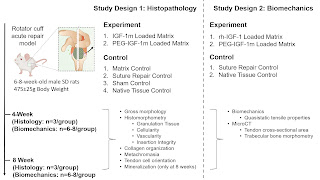Depending on the nature and location of an injury healing may be difficult if not impossible as some tissues have either slow regeneration rate or do not heal at all unless certain conditions are met. An example of this is torn rotator cuff, a common shoulder injury, where the damaged tendons do not heal on their own. Recently, researchers at Novartis, Columbia University, University of Pennsylvania, and University of Connecticut used Poly(lactide-co-caprolactone) PLCL from PolySciTech (www.polyscitech.com) as part of their development of tissue engineering repairs for cartiladge and ligaments. This researchs holds promise to improve traumatic wound repair in the future. Read more: Prabhath, A., Vernekar, V.N., Esdaille, C.J., Eisenberg, E., Lebaschi, A., Badon, M., Seyedsalehi, A., Dzidotor, G., Tang, X., Dyment, N. and Thomopoulos, S., 2022. Pegylated insulin‐like growth factor‐1 biotherapeutic delivery promotes rotator cuff regeneration in a rat model. Journal of Biomedical Materials Research Part A. https://onlinelibrary.wiley.com/doi/abs/10.1002/jbm.a.37378
“Tears in the rotator cuff are challenging to repair because of the complex, hypocellular, hypovascular, and movement-active nature of the tendon and its enthesis. Insulin-like Growth Factor-1 (IGF-1) is a promising therapeutic for this repair. However, its unstable nature, short half-life, and ability to disrupt homeostasis has limited its clinical translation. Pegylation has been shown to improve the stability and sustain IGF-1 levels in the systemic circulation without disrupting homeostasis. To provide localized delivery of IGF-1 in the repaired tendons, we encapsulated pegylated IGF-1 mimic and its controls (unpegylated IGF-1 mimic and recombinant human IGF-1) in polycaprolactone-based matrices and evaluated them in a pre-clinical rodent model of rotator cuff repair. Pegylated-IGF-1 mimic delivery reestablished the characteristic tendon-to-bone enthesis structure and improved tendon tensile properties within 8 weeks of repair compared to controls, signifying the importance of pegylation in this complex tissue regeneration. These results demonstrate a simple and scalable biologic delivery technology alternative to tissue-derived grafts for soft tissue repair.”

No comments:
Post a Comment